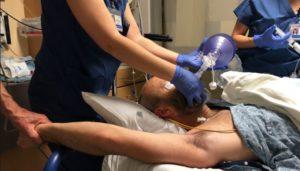Shoulder injuries can be debilitating, and a very painful and limiting one is called frozen shoulder. What is a frozen shoulder? What is frozen shoulder manipulation? What is the frozen shoulder manipulation success rate? What should I expect after shoulder manipulation? What is the best treatment for frozen shoulder? Let’s dig in.
What is a Frozen Shoulder?
Frozen shoulder, also known as adhesive capsulitis, is a painful loss of shoulder movement and range in motion. The incidence of frozen shoulder is 3-5% in the general population and up to 20% in those with diabetes (1). The peak incidence is between 40-60 years of age (2). The exact mechanism is poorly understood. In general, the capsule becomes inflamed, thickened, and contracted with pain and significant restriction in range of motion. Causes are poorly understood but riks factors include trauma, prolonged immobility, systematic diseases such as diabetes, stroke, connective tissue disease, and heart disease. Other causes include post-surgery, chronic inflammation causing stimulation of myofibroblasts (3).
What is Frozen Shoulder Manipulation?

Manipulation under anesthesia (MUA) is a procedure that is performed in a hospital or ambulatory surgery setting. It is performed when conservative therapies have failed. After the patient is anesthetized the surgeon forcefully moves the shoulder in various directions in an effort to stretch or tear the scar tissue. Risks include fracture of the arm bone, dislocation of the shoulder, tears in the rotator cuff and labrum, blood clots, and nerve damage (4). Manipulation under anesthesia is typically combined with an intra-articular steroid injection. Steroids are toxic to cartilage and other orthopedic tissue (5).
Frozen Shoulder Manipulation Success Rate
Success rates vary depending upon the parameters being evaluated and time points. Patient satisfaction varied. Dodenhoff reported that 41% of patients with frozen shoulder were satisfied at six weeks and 87% at three months (6) A 2000 study of 37 patients with frozen shoulder who underwent MUA, at 3 months 59% had no or mild pain and limitation vs 28% had moderate pain and restriction (7) At 15-year followup, Ferrel et al described a mean 8/10 satisfaction level (8). A high-level review of the literature pointed out an important flaw in the studies to date examining the frozen shoulder manipulation success rate. All but one study lacked a control group that did not undergo manipulation (9). This is essential to determine the true effectiveness of a procedure. This is the gold standard in medicine and was incorporated compromising the validity of the reported results.
What Should I Expect After Shoulder Manipulation?
Recovery time varies can vary based upon several factors including the severity of shoulder scarring, general health, and range of motion. Expect pain due to the stretching and tearing of scarred down tissue. Oral narcotics and muscle relaxants are commonly used during the first one to two weeks. Physical therapy is critical and should be instituted early.
What Is the Best Treatment for Frozen Shoulder?
Conservative therapy is the initial treatment of choice. Surgery is often recommended when conservative options have failed. The aim of surgery is to release the scarred shoulder tissue and supporting ligaments. Both surgery and manipulation under anesthesia have similar outcomes at 2 and 3 years (10). Surgery has the risks of bleeding, infection, failure, nerve injury, and rotator cuff injuries. Is there a regenerative option?
Yes! At the Centeno-Schultz Clinic, capsular distention is performed for patients with frozen shoulder and advanced shoulder arthritis. The shoulder joint is first injected with a large volume of local anesthetic which numbs the joint and stretches the capsule. Once the shoulder joint is numb, PRP is injected to further stretch the shoulder capsule. The injected PRP distends the shoulder capsule and provides growth factors to facilitate healing. The shoulder is then put through both active and passive range of motion in an effort the stretch the tight capsule. Regular physical therapy thereafter is important to maintain shoulder range of motion. Is this different than MUA? Absolutely as the former is aggressive torquing of the shoulder joint during a general anesthetic followed by injection of steroid injection which can compromise both the cartilage and rotator cuff tendons. At the Centeno-Schultz Clinic, high dose steroids are not used. Rather PRP which is rich in growth factors is injected using ultrasound guidance.
In Conclusion
Frozen shoulder is also known as adhesive capsulitis and is a painful loss of shoulder movement and range in motion. Its exact cause is poorly understood. Risk factors include trauma, surgery, prolonged immobility and systematic diseases such as diabetes and cardiovascular disease. Manipulation under anesthesia (MUA) is a procedure where the shoulder is aggressively put through maneuvers in an attempt to break up or stretch the scar tissue. Patients undergo general anesthetic and receive a shoulder steroid injection at the completion of the MUA. Frozen shoulder manipulation success rate varies over time and most study designs are flawed as they did not evaluate placebo. Surgery is recommended to those who fail conservative treatment. Surgery and MUA have similar outcomes at 2-3 years. MUA involves the injection of steroids which are toxic to orthopedic tissue and should be avoided. PRP is a safe alternative to steroids and is used at the Centeno-Schultz Clinic in the treatment of frozen shoulders.
1.Manske RC, Prohaska D. Diagnosis and management of adhesive capsulitis. Curr Rev Musculoskelet Med. 2008;1(3-4):180-9.DOI: 10.1007/s12178-008-9031-6.
2.Robinson CM, Seah KT, Chee YH, Hindle P, Murray IR. Frozen shoulder. J Bone Joint Surg Br. 2012;94:1–9.
3. Ko JY, Wang FS, Huang HY, Wang CJ, Tseng SL, Hsu C. Increased IL-1beta expression and myofibroblast recruitment in subacromial bursa is associated with rotator cuff lesions with shoulder stiffness. J Orthop Res. 2008;26(8):1090-7. DOI: 10.1002/jor.20631.
4.Uppal HS, Evans JP, Smith C. Frozen shoulder: A systematic review of therapeutic options. World J Orthop. 2015;6(2):263-8. doi: 10.5312/wjo.v6.i2.263.
5.Wernecke C, Braun HJ, Dragoo JL. The Effect of Intra-articular Corticosteroids on Articular Cartilage: A Systematic Review. Orthop J Sports Med. 2015;3(5):2325967115581163. doi: 10.1177/2325967115581163.
6. Dodenhoff RM , Levy O , Wilson A , Copeland SA . Manipulation under anesthesia for primary frozen shoulder: effect on early recovery and return to activity. J Shoulder Elbow Surg 2000;9:23-26.
7.Hsu JE, Anakwenze OA, Warrender WJ, Abboud JA. Current review of adhesive capsulitis. J Shoulder Elbow Surg. 2011;20:502–514.DOI: DOI: 10.1016/j.jse.2010.08.023.
8.Farrell CM, Sperling JW, Cofield RH. Manipulation for frozen shoulder: long-term results. J Shoulder Elbow Surg. 2005;14(5):480-4. DOI: 10.1016/j.jse.2005.02.012.
9.Kraal T, Beimers L, The B, Sierevelt I, van den Bekerom M, Eygendaal D. Manipulation under anaesthesia for frozen shoulders: outdated technique or well-established quick fix. EFORT Open Rev. 2019;4(3):98-109. doi: 10.1302/2058-5241.4.180044.
10.Sharma S. Management of frozen shoulder – conservative vs surgical. Ann R Coll Surg Engl. 2011;93(5):343-4; discussion 345-6.doi: 10.1308/147870811X582080.

